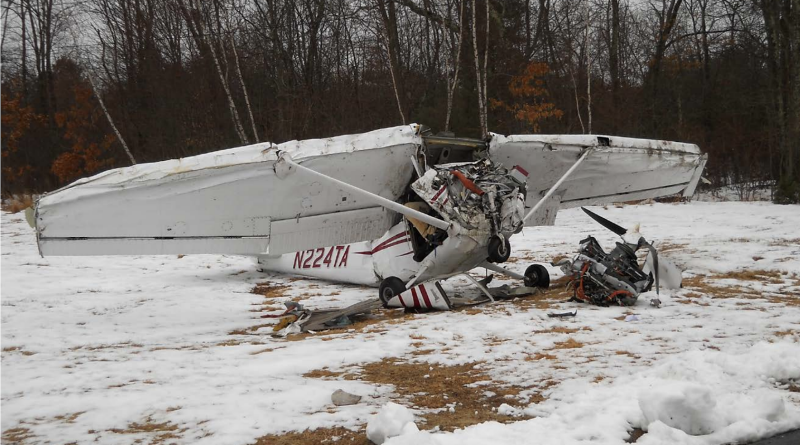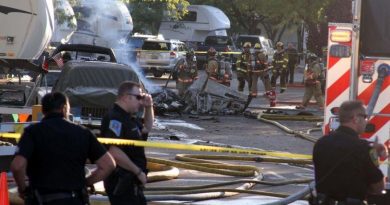Loss of Aircraft Control on Go-Around

After practicing some maneuvers on an instructional flight, the student and instructor of this Cessna 172S returned to the Mansfield Municipal Airport to land just after noon on February 23rd, 2019.
Conditions: VFR, winds light and variable, sky clear, 10SM visibility.
The CFI:
- Age 32
- 368 hours total time, 150hrs in C172.
The Student:
- New student, 7.6hrs logged.
Events Leading to the Incident:
As the aircraft entered the landing flare, the aircraft continued to float above the runway for a substantial distance, most likely due to excessive airspeed. Witnesses said the aircraft did not touch down until about 2,800 feet down the runway. With only 703 feet of runway remaining, a go around was initiated.
Although that runway was left traffic, the aircraft initiated a steep right climbing turn. As the aircraft slowed, it entered a spiraling decent, ultimately coming to rest in a grassy area near the airport terminal building. Both the instructor and student were killed on impact due to blunt force injures.
Examination of the wreckage did not reveal any pre-impact mechanical malfunctions that would have precluded normal operation of the aircraft.
NTSB ruling:
The CFI allowed the Cessna to exceed the critical AOA during the late touch and go landing. No one knows who was on the controls at the time, but ultimately it is the CFI’s responsibility.
What could have been done to avoid this fatal tragedy?
Accidents have a tendency to happen in a chain of unraveling events. As with this incident, there were multiple events that ultimately led to the incident. Please note that it is possible that some of the items below were not immediately addressed or corrected in an effort to support student learning.
1) Airspeed management
Excess aircraft float in the flare can usually be attributed to poor airspeed management on final. Speed is much easier to burn off prior to entering the flare due to ground effect. As you get close to the ground; downwash and wingtip vortices are reduced, which also means a reduction in induced drag (end result, enter ground effect fast, you float a long time). Ensuring a stable approach on glide path with the proper airspeed will significantly assist in setting up for a great landing.
2) Set a go-around point BEFORE crossing the threshold
If your wheels aren’t down by this point, initiate a go-around. Be sure to familiarize yourself with the runway length, gradient or slope, and any obstacle clearance requirements prior to starting your approach.
3) Don’t force the landing
Pushing the nose over in an attempt to force the airplane onto the runway is NEVER a good idea! It can cause the propeller to strike the runway, put undue stress on the landing gear, and cause the aircraft to porpoise (bounce). Focus on your go-around point; if you are still in the flare crossing this point, initiate a go-around. NEVER FORCE THE PLANE TO LAND.
4) Going around? Watch your airspeed and bank angle
Stall speed increases in a turn. This is because as we bank, there is less vertical lift (less lift aimed down at the ground). To avoid descending, we naturally pull back in a turn, which increases total lift, and allows us to turn without losing altitude (pulling back and increasing total lift is what makes you feel the G-forces in your seat). Now this sounds like a great plan, but the more lift you call for by pulling back the more drag you induce on the wing, and the closer you get to your critical AOA (stalling AOA).
It’s easy to pull back too much in a climbing turn, bleed off airspeed, increase your AOA to try and maintain altitude, and wind up pulling back too much and stalling the plane.
Simple answer: Don’t pull back so much.
“But then how will I climb if I don’t pull back?”
Level your wings or decrease your bank angle, this gives you more vertical lift to climb with while making your turn a little wider.
“But I need to turn sharp and climb a lot!”
Well it sounds like you need a bigger engine and better airplane! Every airplane only has so much power and available energy in it, ask the plane to do more than it can and we’ll wind up writing an article about you like these guys. Don’t ask your plane to do more than it can.
More shallow turns and a less steep climb angle should have been used under these flight conditions to reduce loss of lift (but hey, easier said than done).
5) Practice power on stalls
Stalls can happen quickly and aggressively, especially when at maximum power. Practice power on stalls regularly to maintain proficiency in quickly recovering with minimal altitude loss.
6) Conclusion
Let’s be realistic here, the CFI was low time. Is it a good idea for brand new CFI’s to train brand new pilots? In my humble opinion it’s a terrible idea. Brand new CFI’s would most likely create a safer environment for themselves and everyone else if they stuck with slightly more experienced students while being mentored by a more experienced CFI(s) as they gain the experience, confidence, and skills required to teach effectively and maintain the highest levels of safety.



